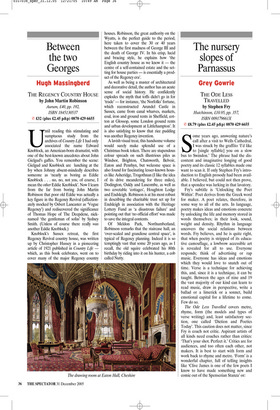Between the two Georges
Hugh Massingberd
THE REGENCY COUNTRY HOUSE by John Martin Robinson Aurum, £40, pp. 192, ISBN 1845130537 ✆ £32 (plus £2.45 p&p) 0870 429 6655 Until reading this stimulating and sumptuous study from the archives of Country Life I had only associated the name Edward Knoblock, an American-born dramatist, with one of the best-known anecdotes about John Gielgud’s gaffes. You remember the scene: Gielgud and Knoblock are lunching at the Ivy when Johnny absent-mindedly describes someone as ‘nearly as boring as Eddie Knoblock . . . no, no, not you, of course, I mean the other Eddie Knoblock’. Now I learn from the far from boring John Martin Robinson that poor old Eddie was actually a key figure in the Regency Revival (affectionately mocked by Osbert Lancaster as ‘Vogue Regency’) and rediscovered the significance of Thomas Hope of The Deepdene, nicknamed ‘the gentleman of sofas’ by Sydney Smith. (Unless of course there really was another Eddie Knoblock.) Knoblock’s Sussex retreat, the first Regency Revival country house, was written up by Christopher Hussey in a pioneering article of 1921 published in Country Life which, as this book celebrates, went on to cover many of the major Regency country houses. Robinson, the great authority on the Wyatts, is the perfect guide to the period, here taken to cover the 30 or 40 years between the first madness of George III and the death of George IV. In his crisp, lucid and bracing style, he explains how ‘the English country house as we know it — the centre of a self-contained estate and the setting for house parties — is essentially a product of the Regency era’.
As well as being a master of architectural and decorative detail, the author has an acute sense of social history. He confidently explodes the myth that toffs didn’t go in for ‘trade’ — for instance, ‘the Norfolks’ fortune, which reconstructed Arundel Castle in Sussex, came from canal wharves, markets, coal, iron and ground rents in Sheffield, cotton at Glossop, some London ground rents and urban development at Littlehampton’. It is also satisfying to know that rice pudding was another Regency invention.
A lavish visual treat, this handsome volume would surely make splendid use of a Christmas book token. There are stupendous colour spreads on such illustrious piles as Windsor, Brighton, Chatsworth, Belvoir, Eaton and Penrhyn, but welcome space is also found for fascinating lesser-known houses like Asheridge, Trogothnan (I like the idea of its drive meandering for three miles), Dodington, Oakly and Luscombe, as well as two covetable ‘cottages’, Houghton Lodge and Endsleigh. Robinson is at his most robust in describing the charitable trust set up for Endsleigh in association with the Heritage Lottery Fund as ‘a disastrous failure’ and pointing out that ‘no official effort’ was made to save the integral contents.
Of Meldon Park, Northumberland, Robinson remarks that the staircase hall, an ‘over-scaled and grandiose central space’, is typical of Regency planning. Indeed it is so temptingly vast that some 20 years ago, as I recall, the old squire celebrated his 80th birthday by riding into it on his hunter, a cob called Nutty.

















































 Previous page
Previous page